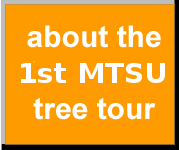
|

|

|
An individual instance of Gymnocladus dioicus (Kentucky coffeetree)
Permanent unique identifier for this particular organism:
http://bioimages.vanderbilt.edu/mtsu/23
Notes:
Description and Adaptation
General: Legume Family (Fabaceae): A medium to large, round-barked native deciduous tree reaching heights of 60-100 feet with a spread of 40 to 50 feet. Its short trunk, 1 to 2 feet in diameter, divides into several large branches that end in contorted, stout twigs. Its unique, thick, dark bark is gray to grayish-brown, often marked with deep, irregular furrows and plates that curl at their sides. The alternate, bipinnately compound leaves are the largest of any native species, measuring from 1 to 3 feet in length by 18 to 24 inches in width, arranged in feather-fashion in 5 to 9 pairs of pinnae, the lowest are reduced to simple leaflets. Typically the leaves consist of six to 14 entire; more or less ovate (almond shaped) leaflets, 2 to 3 inches long.
Relatively hardy in zones 3 to 8, the tree adapts well to urban conditions. It prefers full sun, humus-rich, moist soil, and tolerates drought and occasional flooding. Considering its cultural tolerances, it should be on the list of tough trees. Kentucky coffeetree is a fast-growing tree when young with moderate to slow growth as the tree ages attaining 12 to 14 feet in 10 years.
Uses
Industry: Timber, the strong, heavy wood is used in general construction and fence posts although the rot resistant wood is soft and the staples pull out easily. Pioneer settlers used the coarse-grained, light brown to reddish-brown wood in cabinetry. Also used for ornamental purposes in large area landscape plantings and parks.
Wildlife: Kentucky coffeetree is used by nesting birds. Due to the tree's toxic plant parts such as the leaves and raw seeds, there is little wildlife usage as a source of food.
Ethnobotanic: While native to North America, Native Americans introduced the tree to some parts of the continent as they used the pulp from the wood to treat insanity. A tea was also made from the leaves and pulp and used as a laxative. Early settlers used the seeds of the tree as a substitute for coffee. The seeds and pods contain the toxic alkaloid cystisine (Seed Environmental Concerns). Cystisine is thought to be neutralized in the roasting process.
Conservation: Kentucky coffeetree was formerly planted around farmsteads. It is tolerant to a wide range of conditions such as drought, chalk (limestone), and urban conditions. The tree has been planted on mine spoils for soil reclamation and stabilization. This pest free tree is an alternative to ash and elm which have been ravaged by insects and disease.
Status
Kentucky coffeetree's numbers are declining rapidly due to over harvesting. The species is not invasive; it is only found in small clusters due to root sprouting and makes up a rare component of any woodland.
Environmental Concerns: The leaves, seeds and pulp are poisonous and are toxic to livestock, humans, and pets. Sprouts eaten in the spring have produced toxicosis. Leaves, young sprouts, and seeds with gelatinous matter around them contain the toxin. Cattle have reportedly died after drinking from pools of water contaminated by fallen leaves and seeds from the tree.
References
Row, J.M., & Geyer, W. (2002). Plant fact sheet for Kentucky coffeetree (gymnocladus dioicus). Retrieved from http://plants.usda.gov/java/factSheet

|

|
|
Load database and switch to thumbnail view
Use this stable URL to link to this page:
http://bioimages.vanderbilt.edu/mtsu/23.htm
This particular organism is believed to have managed means of establishment.
This organismal entity has the scope: multicellular organism.
Identifications:
Gymnocladus dioicus
(L.) K. Koch
sec. Tennessee Flora 2014
common name: Kentucky coffeetree
family: Fabaceae
Identified 2016-03-13 by Patrick Phoebus
Location:
Military Memorial, Learning Resources Center, Rutherford County, Tennessee, US
Click on these geocoordinates to load a map showing the location: 35.8471°, -86.3651°
Coordinate uncertainty about: 10 m.
Altitude: 190 m.
Location calculated as average of its images' coordinates.
Occurrences were recorded for this particular organism on the following dates:
2016-03-13
2016-04-08
2016-04-27
The following images document this particular organism.
Click on a thumbnail to view the image and its metadata. Load database and enable navigation by taxon and organism.
